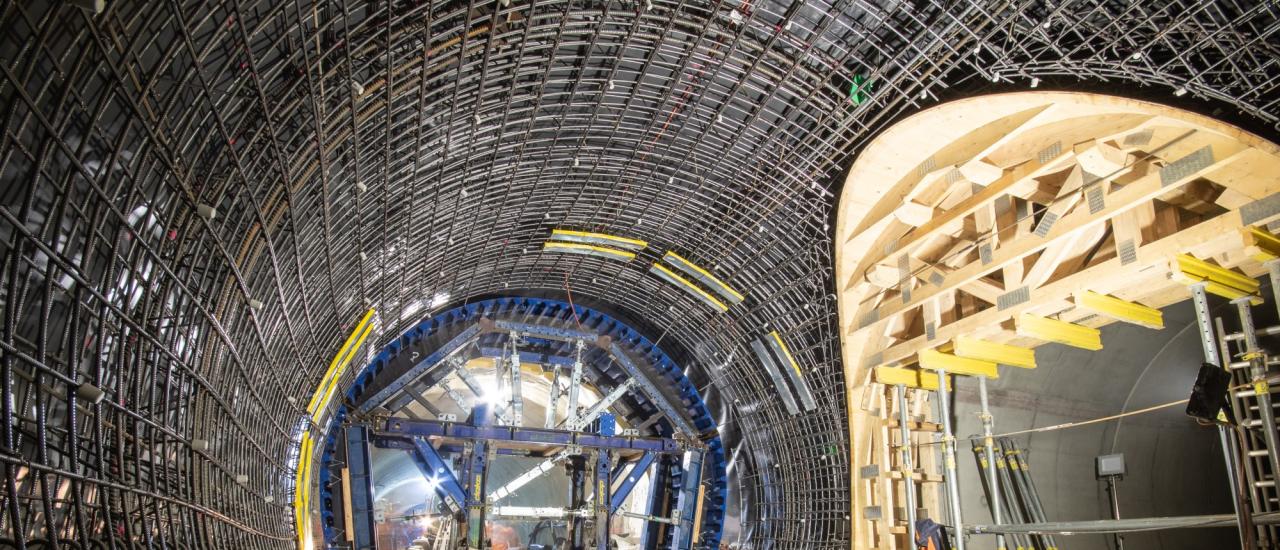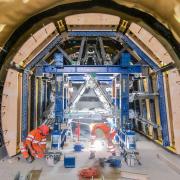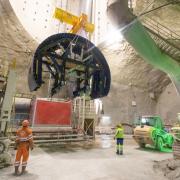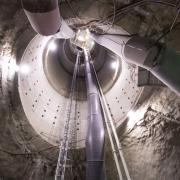
Press Contact
Impressions
Complex workflow
The building work is being done during a planned two-year maintenance shutdown of the accelerator since vibrations during operation of the LHC could affect the experiments. The construction site team is therefore under considerable time pressure to complete the work before the planned restart of the accelerator in early 2021. The specialist in conventional and mechanical tunnel advance, Marti Tunnel AG, has built a custom steel formwork carriage for the 300 m main tunnel. For the formwork for the cross passages, connecting components and stairwells, however, the Marti Tunnel specialists called in Doka’s expertise. The formwork engineers developing these solutions scored points partly thanks to the international cooperation between the engineering teams at Doka’s branches in Zurich and Bern and the tunnel experts in Amstetten. Various elements made the project challenging: the high complexity of the various structures, a need to ensure that formwork elements could be reused and were correctly matched with each other, and the elaborate construction workflow. This meant it was vital for all the engineers in the project to pool their extensive expertise and knowledge and work together to ensure the client could be offered the right solution at the right time for every structure.
Far from traditional tunnelling
Usually, the biggest unknown at a tunnel construction site is the geology. At CERN, though, the construction site team faced rather different challenges. Natalie Schweizer explains further: “This isn’t a typical tunnel construction site. We faced a special challenge when it came to coordinating and planning each construction stage, the construction process and the materials, machines, and human resources available.” Reinforcement might be already underway in one passage while rock was being excavated 200 m away. What made this site particularly challenging was that, although usually there is access at both sides of a tunnel, at CERN the access was constructed as a 60 m deep shaft with a diameter of 12 m. It’s not just the tunnel spoil and 17,800 m3 of in-situ concrete that have to pass through this one bottleneck – the tunnel formwork carriages are also lowered up and down through this shaft.
Doka developed the vault formwork for the four 50-70 m long cross passages, using both standard formwork methods and three formwork carriages. The largest of these SL-1 tunnel formwork carriages is 10 m long, with a diameter of 6.30 m. This carriage had to be designed so that it could be separated longitudinally, or it would not have been able to reach its destination – something that would not have been an issue on a standard tunnel construction site. The Doka engineers accordingly planned four discs 2.5 m wide, with extra attachments that could be secured to the crane. Element by element, the 50 t gantry is lowered through the shaft into the depths. Once it reaches the bottom, excavators shunt it to its work destination with excavators, and it is assembled ready for use.
A nerve-wracking, laborious undertaking in the cramped conditions and given the limited crane capacity. The crane is assembled and positioned in the tunnel under the supervision of and with assistance from the Doka formwork instructor. Usually, formwork carriages only have to be pushed in one direction – but not so in this case. To resolve this, the Doka engineers used the bolt-on wheel sets from a Doka supporting construction frame. With these, the four elements can be manoeuvred accurately inside the tunnel. The bolt-on wheel sets are then removed in the tunnel, and the formwork carriage is set back on its heavy-duty rollers. At the client’s request, the formwork carriage is raised and lowered hydraulically, since it would be extremely laborious to work with a manual pump in the cramped conditions.
About the High Luminosity LHC project – HiLumi
The Large Hadron Collider at CERN is one of the biggest and most complex scientific machines in the world. Since 2010, over 7,000 scientists from 60 countries have been working together near to the German-French border, studying the structure of matter and the fundamental interactions between elementary particles. Various experiments and detectors have been set up along the length of the 27 km circular accelerator running beneath the Swiss canton of Geneva and part of France. The most well-known of these are ATLAS and CMS, known for their contribution to proving the existence of the Higgs boson in 2012. CERN researchers François Englert and Peter Higgs won the Nobel Prize in 2013 for this discovery.
The LHC has been extended and upgraded in the past. Now, in the course of a two-year shutdown ending in spring 2015, plus a further maintenance shutdown from 2019 until the start of 2021, the collision energy is being increased from its original 7 TeV to 13 TeV. A kinetic energy of 7 TeV from a proton corresponds to 99.9999991% of the speed of light. One important result of the planned upgrade is that the collision rate (or, more correctly, “luminosity”) will be increased by a factor of 10, making it possible to measure new particles more precisely and observe rare interactions that it has not so far been possible to see. Supersymmetry and dark matter are just two of the universe’s mysteries that scientists hope to be able to learn more about from the LHC in the not-too-distant future
The LHC is expected to be closed down in 2035. However, various extensions and modifications are also being discussed that might be implemented before then.
- LHC circumference: 26,659 m
- Tunnel diameter: approx. 3.80 m
- The average depth of the tunnel below the earth’s surface: 100 m (min. 50 m, max. 175 m)
- Operating temperature: 1.9 K (-271.3 °C). The LHC is the biggest cooling system in the world and one of the earth’s coldest places
- Electricity consumption: approx. 120 MW, equal to around 1/3 of the electricity consumption of all the households in the canton of Geneva
- Annual data volume: 50,000,000 GB (=50 PB). ATLAS generates approx. 1 GB/s
- Total construction costs: approx. CHF 6.5 billion
This could also be of interest for you:
Do you have any questions on the article? Get in touch with us!





